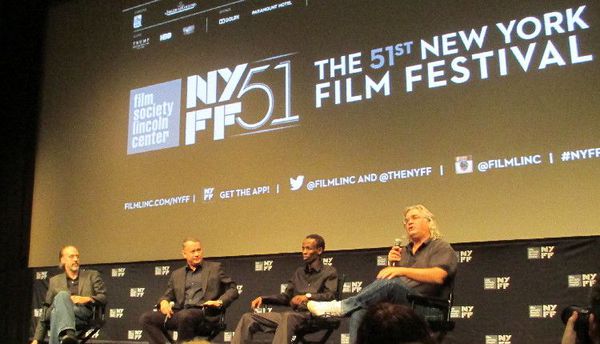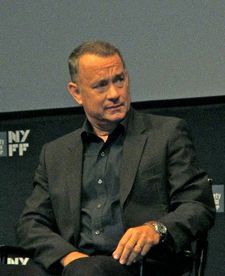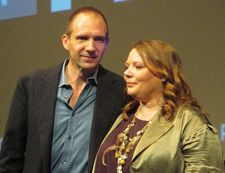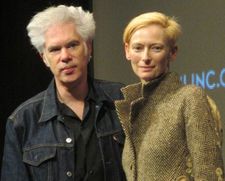 |
| Kent Jones, Tom Hanks, Barkhad Abdi and Paul Greengrass at the New York Film Festival press conference for Captain Phillips Photo: Anne-Katrin Titze |
Captain Phillips
Based on the 2009 hijacking of the US cargo ship Maersk Alabama by Somali pirates, Captain Phillips refuses the traps of the biopic. Tom Hanks, as Captain Phillips, has a truthfulness as powerful as the undertow with storytelling by Paul Greengrass that propels you to the edge of your seat.
Paul Greengrass: "I'm much more comfortable being closer to. It's just an instinct, I think. But that said, if you take this case in point. These events unfolded over four or five days, you've got the challenge of compression. That actually is the essential challenge that we face. How to compress these events and stay true to the fundamentals. I think we did.… It's hard to follow 25 individual destinies in one film."
Tom Hanks on meeting Captain Phillips: "I read his book [A Captain's Duty: Somali Pirates, Navy SEALs, and Dangerous Days at Sea, by Richard Phillips with Stephan Talty] actually prior to reading the screenplay [by Billy Ray]. I did get together with him on two occasions and explained to him, 'You know, I will say things you never said and will be in places you never were'. But if we do this right thematically we will be spot on with the nature of what happened to him. It's a very environmental movie."
 |
| Tom Hanks: 'I will say things you never said and will be in places you never were.' Photo: Anne-Katrin Titze |
"We had never been there it was never part of the schedule. It hadn't been scouted, it wasn't lit. We went down there and had the actual crew of the ship that we were shooting on and Paul said 'What would you do? Shall we give it a try? Very simple, give me a couple of minutes to put up some lights ….' We shot it, I don't know, four or five times…. We had the crew of the infirmary. They didn't know they were going to be in a movie that day. Just the freedom to give it a shot was so liberating. Everybody was up for it. It really made itself.
Greengrass: "Instantly thinking about that scene goes to the heart of it. Acting is many things, playing lines of course. But it's much more profound than that. Acting is truth telling. The actor's job is to divine and embody the truth. That day was a very interesting case in point… There's a shocking sense of humanity and that is an actor finding the truth.
Tom Hanks gives a performance that reflects the cliff and the apprehension pounces over to the audience.
The Invisible Woman
![Ralph Fiennes looks on as Joanna Scanlan explains: 'At that moment I felt great love and tenderness for Felicity [Jones]'.](/images/newsite/Ralph_Fiennes_Joanna_Scanlan_X_225.jpg) |
| Ralph Fiennes looks on as Joanna Scanlan explains: 'At that moment I felt great love and tenderness for Felicity [Jones]'. Photo: Anne-Katrin Titze |
Anne-Katrin Titze: "One of the most telling scenes about Dickens is one he is not in. When Catherine Dickens, his wife, is forced to come and present the piece of jewelry that was mistakenly sent to her, to her husband's mistress. Is that mentioned in the biography? Is it something you added to the screenplay? Where did this telling episode come from?"
Ralph Fiennes: "It's mentioned in Claire Tomalin's book. It's meant to have happened. There is no proof but it's mentioned in biographies that he had a piece of jewelry made for Nelly [Ternan] that was then wrongly sent to Catherine Dickens. And he insisted that she give it back. I suppose in his head he is thinking, 'I've done nothing wrong. I'm not ashamed'. It was always a great scene. The proof of what a great scene it was was when I met Jo [Scanlan] and she very generously agreed to read. Within seconds, the scene that I had believed to be a good scene was, in her hands, a great scene. The way she brilliantly found the dignity in it. Of course, you know, we were married then."
 |
| Ralph Fiennes and Joanna Scanlan, who play Charles and Catherine Dickens in The Invisible Woman Photo: Anne-Katrin Titze |
AKT: "A great mysterious scene."
"Fiennes has brilliantly embodied the larger-than-life creations of writers such as Shakespeare, Dickens, and Graham Greene, among others, and given us an extraordinary body of work to celebrate. The Film Society is excited to honor him at this year’s New York Film Festival not only as an actor, but as the director of The Invisible Woman, truly one of the noteworthy films of the year." - The Film Society of Lincoln Center’s Executive Director Rose Kuo said in a statement.
Only Lovers Left Alive
 |
| Film critic Amy Taubin, Jim Jarmusch and Tilda Swinton talk about blood-sipping creations Photo: Anne-Katrin Titze |
Anne-Katrin Titze: "You mentioned the gloves as something you added to the myth of vampires. I think you also added a new hairstyle for vampires. I am also curious about the choice of costumes, especially Eve's beautiful embroidery on many garments. It matches the timelessness [and utopian quality] of the music you mentioned."
Jim Jarmusch: "I'll talk about the hair and [Tilda will speak about the costumes]. The hair thing was really interesting. I wanted them to have wild hair. I wanted them to look partly animalistic and even behave like part animals, part very sophisticated humans. We were trying to make these wigs for them and we were trying on different things, working in Germany with Gerd [Zeiss], our make-up and hair designer.
"We were trying to get an interesting texture. We were looking at different textures of hair in photographs online on the internet. And Tilda said, you keep saying 'animal', the animal thing is missing, so why are we just looking at humans, we should be looking at animal fur. So we started looking at animals, different monkeys and llamas and different textures of fur and hair. And then Gerd said that he had in the past mixed some goat and yak fur into human hair. And Tilda was like, 'Let's try it out!'. So in the end, the wigs for John Hurt, for Tilda, for Tom, and for Mia were made out of a certain percentage of human hair mixed with goat and yak hair. Again, why? I wanted them to look kind of wild.
 |
| Jim Jarmusch with Tilda Swinton on a new hairstyle for vampires Photo: Anne-Katrin Titze |
"It was very important and Jim was very clear on that with Bina [Daigeler], our great costume designer, trying to kind of strip all the elements, every blouse, every jacket of anything contemporary or any remotely fashion reference. Although they had to feel that they could have been at any time. It occurred to me, I made a film once called Orlando… the last thing I ended up wearing in that film was a plain silk shirt and a pair of breeches, pale suede trousers and that's what we start with in this film.
"This feeling of trying to find the lowest common denominator and being cohesive - the conversation of what could you have worn in previous centuries? What could you have worn in the 18th century? What could you be wearing now? The now wasn't really that important to us. But what could have lasted? Like John Hurt wearing that jacket he loved for 500 years. Why not? That feeling of things lasting and then not being tied to time. It's easy to say, but it's very difficult to actually free ourselves from hanging on. This looks 50s? Let's refine it again! That makes it look like nothing, a bit 50s, a bit 70s, a bit 1580s. When it's all fudgy and vague then you're starting to land."
JJ: "I like the detail when Eve notices that Adam's dressing gown is like 200 years old. It seemed very familiar."





















